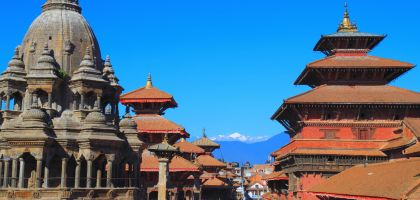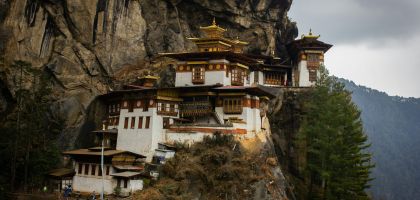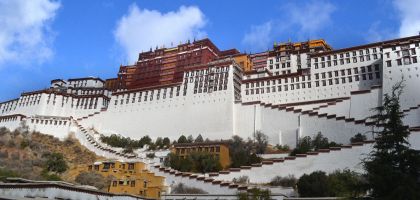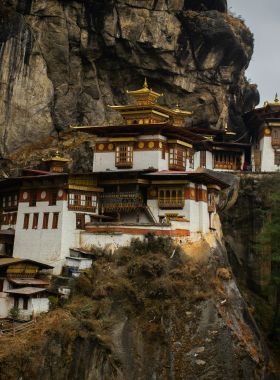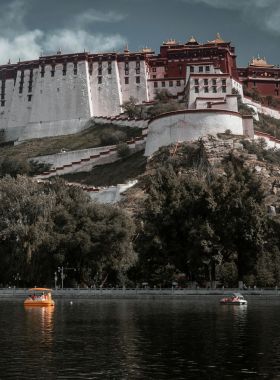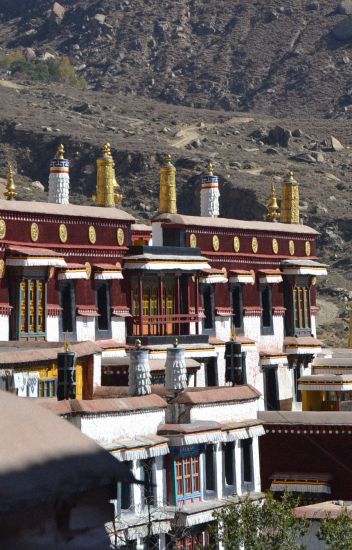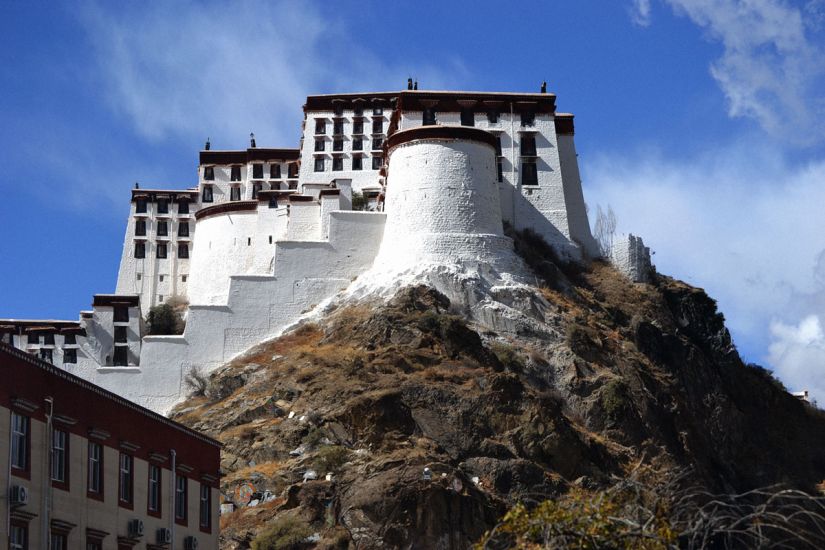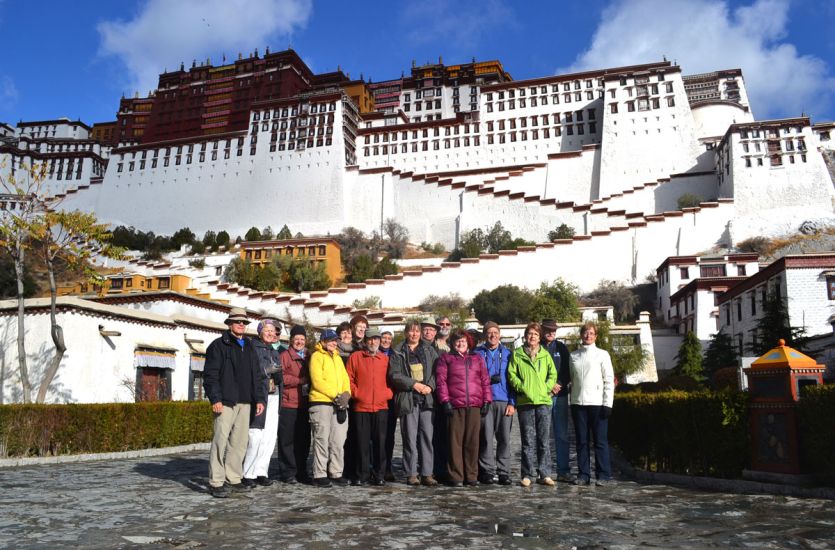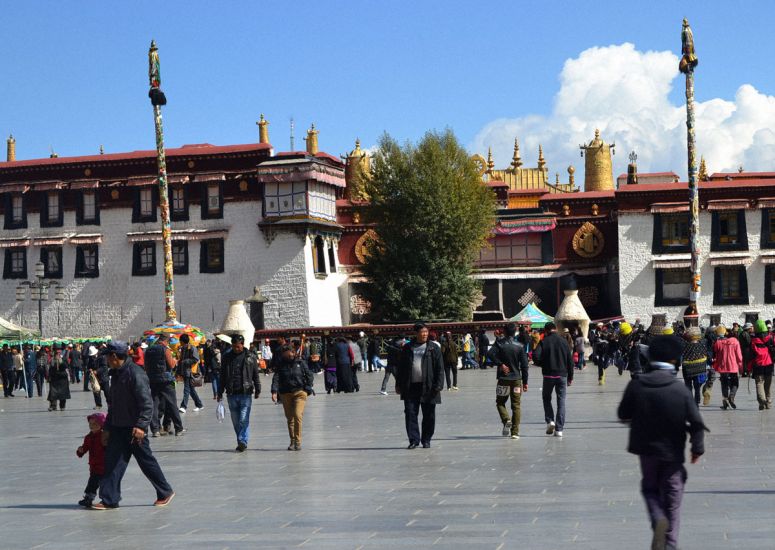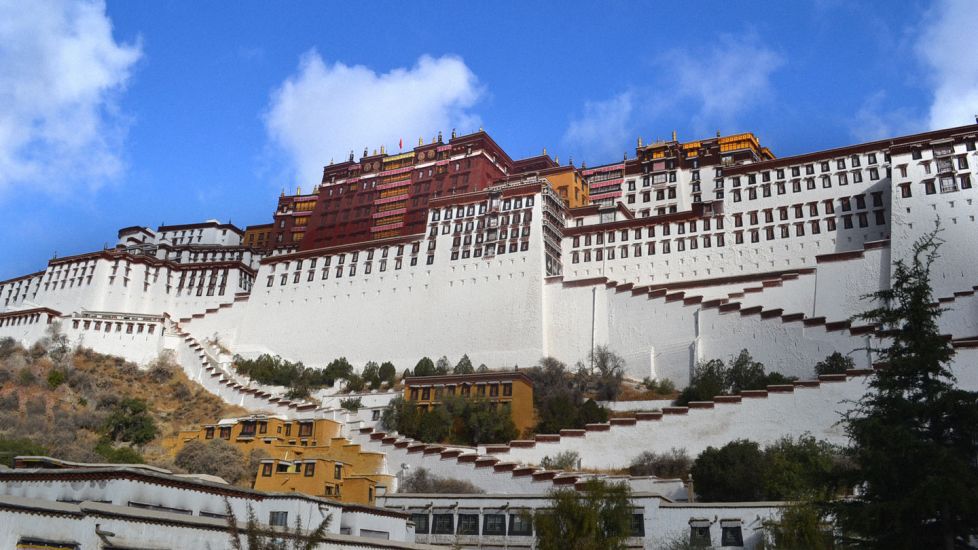Lhasa Samye Tsedang Tour
6 Days / Tibet
Activity
Difficulty Level
Destinations
Trip Start / End
Accommodation
Travel Style
Best time to travel
Personalized Travel Advice

Dev Raj Nepal
+977 9851096523
Detailed Itinerary
01
DAY
01
Touch down at Gonggar Airport, where the crisp Himalayan air greets you with a whisper of adventure. From the airport, you will take a scenic drive toward Lhasa, the spiritual and cultural capital of Tibet. The journey offers your first glimpses of the vast Tibetan Plateau, with rugged mountains standing like silent sentinels along the way.
Upon reaching Lhasa, check into your hotel where you can unwind and allow your body to adjust to the high-altitude environment. Today is about taking it slow, hydrating well, and embracing the peaceful rhythm of Tibet. The city, sitting at 3,650m (11,975ft), pulses with a deep spiritual energy, but for now, rest is the priority. Tomorrow, the wonders of Lhasa await.
Arrival in Lhasa
Touch down at Gonggar Airport, where the crisp Himalayan air greets you with a whisper of adventure. From the airport, you will take a scenic drive toward Lhasa, the spiritual and cultural capital of Tibet. The journey offers your first glimpses of the vast Tibetan Plateau, with rugged mountains standing like silent sentinels along the way.
Upon reaching Lhasa, check into your hotel where you can unwind and allow your body to adjust to the high-altitude environment. Today is about taking it slow, hydrating well, and embracing the peaceful rhythm of Tibet. The city, sitting at 3,650m (11,975ft), pulses with a deep spiritual energy, but for now, rest is the priority. Tomorrow, the wonders of Lhasa await.
02
DAY
02
Today, prepare to stand in the presence of one of Tibet’s most awe-inspiring structures—the Potala Palace. This grand fortress, with its towering white and red walls, once served as the winter residence of the Dalai Lama and remains a beacon of Tibetan identity. Step inside, where golden stupas, intricate murals, and vast halls tell stories of Tibet’s spiritual and political past. From the palace’s heights, the city stretches beneath you, a stunning contrast of ancient devotion and modern life.
Next, visit Sera Monastery, one of Tibet’s last remaining Gelugpa (Yellow Hat Sect) monasteries. If timing allows, witness the famous monk debates, where young scholars engage in animated philosophical discussions—clapping their hands and making grand gestures as they challenge each other’s understanding of Buddhist doctrine.
Conclude your day at Norbulingka, a serene retreat that once served as the summer palace of the Dalai Lama. Stroll through its beautifully manicured gardens and tranquil courtyards, where Tibetan rulers once sought solace away from the affairs of state. As the day winds down, return to your hotel, your mind filled with visions of Tibet’s grand history and spiritual depth.
Lhasa Exploration
Today, prepare to stand in the presence of one of Tibet’s most awe-inspiring structures—the Potala Palace. This grand fortress, with its towering white and red walls, once served as the winter residence of the Dalai Lama and remains a beacon of Tibetan identity. Step inside, where golden stupas, intricate murals, and vast halls tell stories of Tibet’s spiritual and political past. From the palace’s heights, the city stretches beneath you, a stunning contrast of ancient devotion and modern life.
Next, visit Sera Monastery, one of Tibet’s last remaining Gelugpa (Yellow Hat Sect) monasteries. If timing allows, witness the famous monk debates, where young scholars engage in animated philosophical discussions—clapping their hands and making grand gestures as they challenge each other’s understanding of Buddhist doctrine.
Conclude your day at Norbulingka, a serene retreat that once served as the summer palace of the Dalai Lama. Stroll through its beautifully manicured gardens and tranquil courtyards, where Tibetan rulers once sought solace away from the affairs of state. As the day winds down, return to your hotel, your mind filled with visions of Tibet’s grand history and spiritual depth.
03
DAY
03
Your morning begins at Drepung Monastery, once the largest monastery in Tibet and a major cent0er of learning. Walk through its massive courtyards, where generations of monks have gathered for study and meditation. Its whitewashed walls cling to the mountainside, offering spectacular views of the surrounding valley.
Next, step into the sacred heart of Tibetan Buddhism—the Jokhang Temple. Pilgrims from all corners of Tibet prostrate themselves at its entrance, their devotion etched into the very stones of the temple floor. Inside, flickering butter lamps illuminate ancient statues, including the revered Jowo Shakyamuni, a golden statue believed to be one of the most sacred relics in Tibet.
Outside the temple, Barkhor Street beckons—a lively marketplace and sacred pilgrimage route in one. Join the throng of pilgrims spinning prayer wheels as they circumambulate the Jokhang, then explore the market’s stalls, where vendors sell prayer beads, traditional thangka paintings, and Tibetan handicrafts. Absorb the sights, sounds, and energy of this bustling center before retiring to your hotel for the night.
Lhasa Exploration
Your morning begins at Drepung Monastery, once the largest monastery in Tibet and a major cent0er of learning. Walk through its massive courtyards, where generations of monks have gathered for study and meditation. Its whitewashed walls cling to the mountainside, offering spectacular views of the surrounding valley.
Next, step into the sacred heart of Tibetan Buddhism—the Jokhang Temple. Pilgrims from all corners of Tibet prostrate themselves at its entrance, their devotion etched into the very stones of the temple floor. Inside, flickering butter lamps illuminate ancient statues, including the revered Jowo Shakyamuni, a golden statue believed to be one of the most sacred relics in Tibet.
Outside the temple, Barkhor Street beckons—a lively marketplace and sacred pilgrimage route in one. Join the throng of pilgrims spinning prayer wheels as they circumambulate the Jokhang, then explore the market’s stalls, where vendors sell prayer beads, traditional thangka paintings, and Tibetan handicrafts. Absorb the sights, sounds, and energy of this bustling center before retiring to your hotel for the night.
04
DAY
04
Bid farewell to Lhasa as you embark on a four-hour drive to Tsedang. Along the way, traverse the vast landscapes of the Yarlung Valley, often referred to as the cradle of Tibetan civilization. En route, cross the mighty Yarlung Tsangpo River by ferry and arrive at Samye Monastery—Tibet’s first and most historically significant monastery. Built in the 8th century, its mandala-inspired design reflects Buddhist cosmology, with a central temple representing Mount Meru, the sacred center of the universe.
After exploring Samye’s ancient halls, continue to Tsedang, one of Tibet’s oldest towns. Check into a luxury hotel, where you can refresh before taking a leisurely stroll through the Tibetan quarter, where the past mingles with the present in the rhythm of daily life.
Drive to Tsedang via Samye Monastery
Bid farewell to Lhasa as you embark on a four-hour drive to Tsedang. Along the way, traverse the vast landscapes of the Yarlung Valley, often referred to as the cradle of Tibetan civilization. En route, cross the mighty Yarlung Tsangpo River by ferry and arrive at Samye Monastery—Tibet’s first and most historically significant monastery. Built in the 8th century, its mandala-inspired design reflects Buddhist cosmology, with a central temple representing Mount Meru, the sacred center of the universe.
After exploring Samye’s ancient halls, continue to Tsedang, one of Tibet’s oldest towns. Check into a luxury hotel, where you can refresh before taking a leisurely stroll through the Tibetan quarter, where the past mingles with the present in the rhythm of daily life.
05
DAY
05
Tsedang is a land of kings and legends, where Tibet’s earliest rulers established their dynasties. Your journey begins at Tradruk Temple, one of the oldest temples in Tibet, believed to have been built in the 7th century by King Songtsen Gampo. Inside, admire the temple’s precious thangka, said to be created from a thousand pearls.
Next, ascend to Yambulakhang Palace, a striking fortress perched on a hilltop overlooking the Yarlung Valley. This first palace of Tibet is shrouded in myth, believed to have been built for Tibet’s first king, Nyatri Tsenpo, who, according to legend, descended from the heavens. From the top, take in the sweeping views of Tibet’s golden fields and distant mountains.
Finally, travel to Chongye Valley, home to the burial mounds of Tibetan kings. These ancient tombs, some dating back over a thousand years, are the final resting places of Tibet’s great rulers, linking the present to the distant past.
As the sun sets, return to Tsedang, where a final night in Tibet allows you to reflect on the spiritual and historical depths of your journey.
Tsedang Exploration
Tsedang is a land of kings and legends, where Tibet’s earliest rulers established their dynasties. Your journey begins at Tradruk Temple, one of the oldest temples in Tibet, believed to have been built in the 7th century by King Songtsen Gampo. Inside, admire the temple’s precious thangka, said to be created from a thousand pearls.
Next, ascend to Yambulakhang Palace, a striking fortress perched on a hilltop overlooking the Yarlung Valley. This first palace of Tibet is shrouded in myth, believed to have been built for Tibet’s first king, Nyatri Tsenpo, who, according to legend, descended from the heavens. From the top, take in the sweeping views of Tibet’s golden fields and distant mountains.
Finally, travel to Chongye Valley, home to the burial mounds of Tibetan kings. These ancient tombs, some dating back over a thousand years, are the final resting places of Tibet’s great rulers, linking the present to the distant past.
As the sun sets, return to Tsedang, where a final night in Tibet allows you to reflect on the spiritual and historical depths of your journey.
06
DAY
06
As your time in Tibet draws to a close, enjoy a final breakfast before your transfer to Gonggar Airport. The echoes of chanting monks, the scent of juniper incense, and the sight of prayer flags fluttering against the Himalayan sky will stay with you long after you depart.
Departure from Tsedang
As your time in Tibet draws to a close, enjoy a final breakfast before your transfer to Gonggar Airport. The echoes of chanting monks, the scent of juniper incense, and the sight of prayer flags fluttering against the Himalayan sky will stay with you long after you depart.
Includes / Excludes
Inclusions
-
Accommodation on twin sharing.
-
Daily Breakfast.
-
All transfers and sightseeing by a private air conditioned car or coach.
-
Sightseeing admission fees.
-
English speaking Tour Guide.
-
Tibet Travel Permit.
Exclusions
-
International and internal air fares.
-
Airport Taxes.
-
Chinese visa fee.
-
Lunch and dinner except as indicated.
-
Travel & Health Insurance.
-
All extra expenses caused due to nature or unforeseen events.
-
Excess baggage charges.
-
Optional tipping to local staffs, hotels etc.
-
Items of a personal nature (sodas, alcoholic beverages, laundry, telephone etc)
Trip Info
The best time to visit Tibet is during the spring and autumn months, from April to June and September to October. These seasons offer the most favorable weather conditions, ensuring a comfortable and enjoyable journey.
Spring (April to June)
Spring in Tibet brings clear skies, mild temperatures, and stunning landscapes as the region begins to bloom with vibrant colors. This is the perfect time for sightseeing and outdoor activities, with the weather being ideal for exploring Tibet’s high-altitude wonders. The snow-capped mountains are particularly striking during these months.
Autumn (September to October)
Autumn is another excellent time to visit, as the temperatures remain pleasant and the landscapes are painted in golden hues. This season marks the harvest period, and the weather is perfect for trekking, photography, and visiting Tibet’s monasteries and sacred sites. The clear skies and crisp air enhance the beauty of Tibet’s natural wonders.
Summer (July to August)
Though summer is a popular time to visit Tibet due to warmer temperatures, it coincides with the monsoon season. Expect occasional rainfall and cloudy weather, which can make some trekking routes less accessible. However, the lush, green landscapes and fewer tourists make it an appealing option for some travelers.
Private Vehicles
Throughout the trip, private vehicles will be used for transfers and sightseeing. These include comfortable cars or SUVs, which are good for navigating both urban and rural areas. These vehicles are chosen for their comfort and reliability, ensuring a smooth and enjoyable journey between destinations. They are equipped to handle various road conditions and provide a high level of convenience for travelers.
Minivans or Buses
For group travel of more than 8 people Buses will be used and for a smaller group of people, Minivans can be used. These vehicles are suitable for accommodating larger groups and offer ample space for passengers and luggage. Equipped with air conditioning and comfortable seating, these vehicles are designed to enhance travel comfort over longer distances. They also offer better stability and space for scenic drives and excursions.
Accommodations for this trip are based on twin-sharing arrangements, ensuring comfort and convenience throughout your journey. If you prefer a single room, a single supplement can be arranged upon request for an additional cost.
In Tibet, the accommodations shift to reflect the region’s unique character. In cities like Tsedang, Lhasa, Gyantse, and Shigatse, you’ll find mid-range hotels, and more upscale options. While accommodations in Tibet may be simpler than in Kathmandu, they are typically well-maintained and offer cozy rooms with essential facilities to ensure comfort. Some places even provide beautiful views of the surrounding Tibetan landscapes, including snow-capped mountains and serene lakes. Whether you stay in a traditional Tibetan-style lodge or a modern hotel with warm hospitality, each location invites you to rest and recharge after a day of cultural and scenic exploration.
In Tibet, families can enjoy a delightful mix of Chinese-inspired dishes along with unique Tibetan flavors. Traditional staples like Tsampa, a nutritious dough made from roasted barley flour, provide a wholesome option for children. Another favorite is Tibetan dumplings or Thukpa, a hearty noodle soup. Higher-end hotels and restaurants (3-star and above) often cater to international tourists, offering a variety of Western cuisine. This can be particularly comforting for children who may be hesitant to try unfamiliar foods.
Spiritual Immersion in Lhasa
As you arrive in Lhasa, you will be immediately immersed in the spiritual energy that permeates the city. With its rich Tibetan Buddhist heritage, Lhasa is home to some of the most iconic sites in Tibet. The Potala Palace, a stunning architectural marvel, will be one of the highlights of your journey. As you wander through its intricate halls and courtyards, you’ll feel the weight of centuries of spiritual history. Jokhang Temple, the holiest site in Tibetan Buddhism, will further connect you to the devout spirit of the region. You will see pilgrims prostrating themselves in devotion, spinning prayer wheels, and lighting butter lamps, offering a glimpse into the profound daily practices of Tibetan Buddhism.
Cultural Wonders and Monastic Life
On your Tibet tour, you will also explore the lively monastic life that still thrives in Lhasa. Visiting Sera and Drepung Monasteries, you’ll be transported to centers of scholarly learning where you may encounter monks engaged in passionate debates on Buddhist philosophy. These debates are an integral part of the Tibetan Buddhist tradition, and witnessing them will offer insight into the depth of Tibetan intellectual and spiritual life. The peaceful environment at these monasteries is an ideal setting for reflection and spiritual discovery, allowing you to feel the contemplative atmosphere that defines Tibetan monastic culture.
The Historic Significance of Samye Monastery
Traveling beyond Lhasa, you will venture to Tsedang, home to Samye Monastery, the first monastery ever built in Tibet. Samye’s historical significance cannot be overstated, as it marks the birth of Tibetan Buddhism. Surrounded by a serene landscape, this sacred site offers you a chance to walk in the footsteps of early Tibetan Buddhists and experience the foundational moments of the region’s spiritual history. With its ancient architecture and stunning backdrop, Samye provides not only a glimpse into Tibet’s religious past but also a chance to reflect on the evolution of Buddhism in this mystical land.
Pilgrimage and Sacred Sites
Throughout your journey, you will encounter Tibetan pilgrims who continue to travel long distances to visit sacred sites such as Jokhang Temple, Samye Monastery, and other historical landmarks. Witnessing their devotion as they perform rituals, such as spinning prayer wheels and offering butter lamps, you’ll gain a deeper appreciation for the enduring spiritual traditions that shape life in Tibet. The sacredness of these places, coupled with the devotion of the people, will offer you a transformative experience that connects you to the essence of Tibetan Buddhism, making this tour not just a sightseeing journey but a profound spiritual exploration.
High Altitude Considerations
Tibet is known for its high-altitude landscapes, and much of your journey will take place at elevations that can exceed 12,000 feet. As you travel, you’ll be visiting some of the highest monasteries in the world and witnessing spectacular views from towering heights. The altitude can affect some travelers, so it is important to take it slow and give yourself time to acclimatize to avoid symptoms of altitude sickness. The itinerary is designed to allow for gradual acclimatization, ensuring your comfort as you explore the wonders of Tibet. Make sure to stay hydrated, rest when needed, and follow the guidance of your local guide to adjust to the elevation.
Scenic Drives Through Tibet’s Majestic Landscape
Prepare to be awe-struck by the scenic drives that will unfold during your journey through Tibet. The drive from Lhasa to Tsedang takes you along the stunning Yarlung Valley, where the rugged mountains rise majestically on either side. The ferry ride across the Yarlung Tsangbo River to Samye Monastery adds to the sense of adventure, as you cross one of Tibet’s most sacred waterways. The journey itself offers spectacular panoramic views, including snow-capped peaks, vast open plains, and Tibetan villages tucked along the riverside. Every bend in the road reveals a new vista, from barren hills to fertile valleys, ensuring that your time in Tibet will not just be about the destinations but the mesmerizing landscapes you encounter along the way.
FAQs
Personalized Travel Advice

Dev Raj Nepal
+977 9851096523
